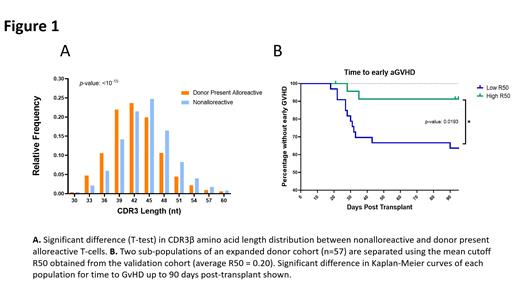Acute Graft-versus-Host Disease (GvHD) is mediated by T-cells recognizing alloantigens. Despite advances in prophylactic regimens that broadly deplete T-cells, incidence of acute GvHD remains high, suggesting that there is a need to further characterize alloreactive T-cells specifically. Using mixed-lymphocytes reactions (MLR) and high-throughput T cell receptor (TCR) sequencing of third complementarity-determining region (CDR3) of the TCRβ chain, we identified and characterized alloreactive T-cell clones in donor-recipient pairs of allogeneic hematopoietic cell transplantation.
We sequenced and identified a total of 34,903 unique donor-derived CDR3β functional sequences (FS) from 20 donor-recipient in vitro MLRs using peripheral blood mononuclear cells (PBMC) collected from donors and patients pre-transplant. We also sequenced the respective unstimulated donor PBMC samples (Donor Type: 13 HLA-Matched/7 Mismatched, GvHD prophylaxis: 11 Tacrolimus (Tac)-Methotrexate/8 Tac-MMF/1 Sirolimus, PTCy: 12 Yes/8 No). On average, our identified alloreactive FS make up a small fraction of the sampled donor repertoire in comparison to nonalloreactive FS. (Mean fraction: 0.004 vs. 0.996, p < 0.0001)
Surprisingly, we found that alloreactive FS have significantly shorter CDR3β length compared to nonalloreactive FS (mean nt 43.50 vs. 44.40, p < 10E-15). We also found that alloreactive FS which can be located within the unstimulated donor sample (n= 4522) are shorter in comparison to all derived alloreactive FS (mean nt 42.43 vs. 43.50, p < 10E-15) and to nonalloreactive FS (mean nt 42.43 vs. 44.40, p < 10E-15) (Figure 1A).
Publicly shared FS have, on average, shorter CDR3β length and are overrepresented among FS associated with autoreactivity and cross-reactivity (Khosravi-Maharlooei et al., J Clin Invest, 2019). Thus, we hypothesized that alloreactive FS may be also publicly shared. We derived a list of shared FS from our donor samples, where if a FS is found in more than one donor, it is considered shared. Alloreactive clones were significantly more likely to be shared compared to nonalloreactive (OR 1.94; CI 95%: 1.88 to 2.01). In addition, using a publicly available set of cross-reactive FS (https://vdjdb.cdr3.net/search), we found that alloreactive sequences are also highly cross-reactive compared to nonalloreactive sequences (OR 6.6; CI 95%: 5.18 to 8.42).
FS with greater levels of sharedness appear more frequently within a repertoire (Madi et al., Genome Res, 2014). As alloreactive sequences are highly shared, we hypothesized that donor repertoires with greater proportion of shared and alloreactive FS will increase the odds of developing clinically significant GvHD (Grade 2-4) in the recipient. Indeed, within donor repertoires, we found a higher fraction of alloreactive sequences amongst the highly expressed FS (The top 50% of FS in repertoire frequency) which correlated with development of GvHD in recipients post-transplant (mean fraction: GvHD+ group 0.013 vs GvHD- group 0.004, p < 10E-7).
Due to the higher portion of shared and alloreactive FS in the top half of the donor T-cell repertoire, we used R50, an index that estimates the diversity of the top 50% of a donor repertoire, to predict the development of GvHD. Utilizing an initial validation cohort of 12 donors, we found that donors whose corresponding recipients developed GvHD within the first 3 months post-transplant had significantly lower R50 compared to those that did not develop GvHD (R50 of 0.096 vs 0.345 p < 0.0001). We also conducted a time-to-event analysis regarding GvHD development in the first 90 days post-transplant. Using the average R50 of the validation cohort as the cutoff for low and high R50 (Average R50: 0.20), we found, in an expanded bi-institutional cohort (n=57), that those with lower R50 values had a significantly greater risk of GvHD compared to those with higher R50 (Figure 1B).
In conclusion, our data suggests that functional alloreactive T lymphocytes are characterized by shorter TCRβ CDR3 length. These FS are highly shared and cross-reactive, suggesting a common mechanism underlying the selection of alloreactive and autoreactive clones. From there, we were able to develop and validate a diversity metric that predicts GvHD development pre-transplant based on the donor T-cell repertoire. These findings have implications for donor selection and need to be examined prospectively.
Disclosures
Reshef:TScan Therapeutics: Consultancy.


This feature is available to Subscribers Only
Sign In or Create an Account Close Modal